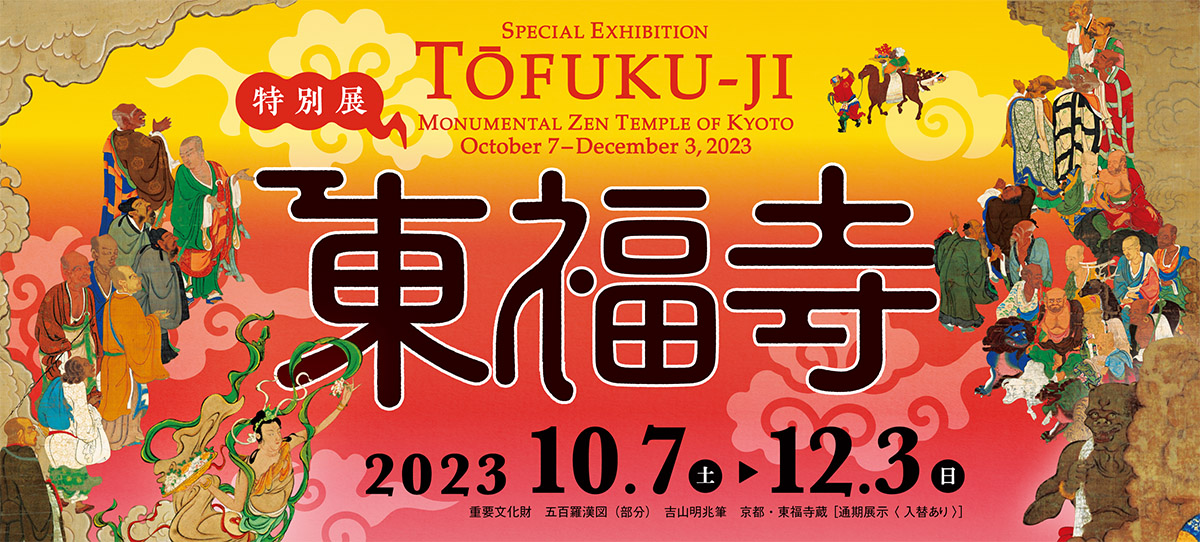- TOP
- Exhibitions
- Special Exhibitions
- Special Exhibition Tōfuku-ji: Monumental Zen Temple of Kyoto
General Information
- Exhibition Title
-
Special Exhibition
Tōfuku-ji: Monumental Zen Temple of Kyoto
- Period
-
October 7–December 3, 2023
The exhibition has two installations:
Part I: October 7–November 5, 2023
Part II: November 7–December 3, 2023
Some artworks may be rotated during the exhibition period.
- Venue
-
Kyoto National Museum, Heisei Chishinkan Wing
- Closed
-
Mondays
*The museum will be open on Monday, October 9, and closed on Tuesday, October 10, 2023.
- Special Exhibition Hours
-
9:00 a.m.–5:30 p.m. (entrance until 5:00 p.m.)
- Special Exhibition Admission
-
Adult 1,800 yen
(1,600 yen)University Student 1,200 yen
(1,000 yen)High School Student 700 yen
(500 yen)- The discounted prices in parentheses ( ) are advance ticket and group ticket rates.
- Advance tickets will be on sale between August 21 and October 6th at major ticket outlets and other locations.
- See the exhibition's official website (in Japanese only) for information about advance and discount advance tickets.
- Group ticket rates apply to groups of 20 people or more.
- Please show student ID for student admission.
- Admission is free for junior high school students and other youths age 0–15, as well as for visitors with disabilities and one caretaker. Please show ID.
- Admission is reduced by 500 yen for Campus Members (including faculty) able to produce ID.
- Audio Guide
-
Venue Rental Edition
- Fee
- 650 yen (includes tax)
- Duration
- approx. 40 min
- Languages
- Japanese, English
- Rental Hours
- 9:00 a.m.-5:00 p.m. (return by 5:30 p.m.)
App Edition
- Fee
- 800 yen (includes tax)
- Languages
- Japanese
- Period of Availability
- March 8–December 15, 2023 (planned)
- Catalogue
-
For availability and purchasing information, see Exhibition Catalogues and Related Publications
- Organized by
-
Kyoto National Museum; Tofukuji Temple; The Yomiuri Shimbun; NHK (Japan Broadcasting Station) Kyoto; NHK Enterprises, Inc. Osaka Branch Office
- With the support of
-
Iwatani Corporation; Kinden Corporation; Daiwa House Industry Co., Ltd.; Non-Destructive Inspection Co., Ltd.
- With the cooperation of
-
Live Art Books
- In conjunction with
-
Kyoto Chamber of Commerce and Industry
- Special Exhibition Official Website
- The official exhibition website is no longer in service.
Description of Exhibition
Famed for its spring verdure and autumn foliage, Tōfuku-ji is one of Kyoto’s most important Zen temples. Tōfuku-ji is known especially for its expansive precincts, which boast an array of colossal structures dating back as far as the medieval period.
This exhibition offers the rare opportunity to view many of Tōfuku-ji’s greatest treasures in a single venue. Notably, the legendary Buddhist painter Minchō’s Five Hundred Arhats are being displayed in their entirety for the first time since the completion of their years-long conservation. The exhibition also showcases several monumental masterpieces of Buddhist sculpture, painting, and calligraphy befitting the grand scale of this monastic complex. Tōfuku-ji’s history itself exemplifies the cosmopolitan Zen culture that blossomed through exchanges with the rest of Asia. In exploring this temple’s significance within Japanese culture, the exhibition illuminates Tōfuku-ji’s enduring appeal from its founding through the present.
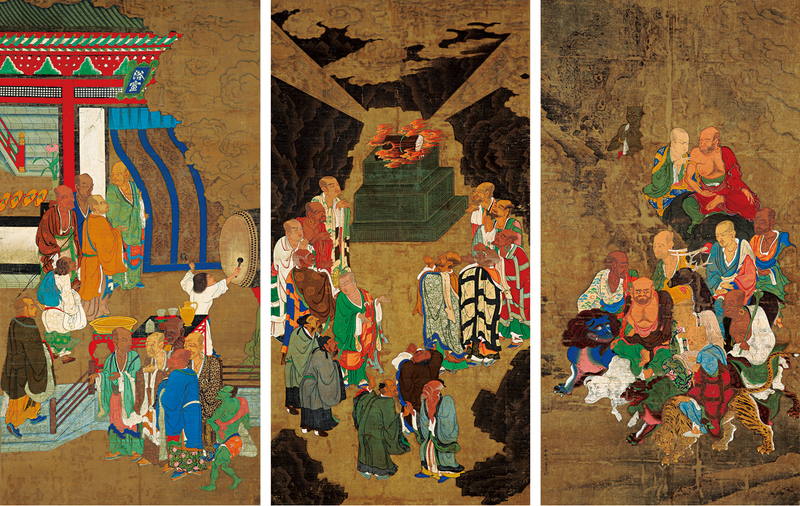
Important Cultural Property
The Five Hundred Arhats
By Minchō
Tōfuku-ji, Kyoto
(Center) Scroll No. 1 [on view Oct. 7–22, 2023]
(Right) Scroll No. 20 [on view Oct. 24–Nov. 5, 2023]
(Left) Scroll No. 40 [on view Nov. 21–Dec. 3, 2023]
Chapter 1 Enni and the Founding of Tōfuku-ji Temple
In 1235, the monk Enni (1202–1280) travelled to China to study under Wuzhun Shifan (1177–1249), a prominent figure in the world of Song-dynasty Zen (Ch: Chan) Buddhism. After returning to Japan, Enni founded Jōten-ji Temple in Hakata, Fukuoka. He later gained favor with the highest authority at the imperial court, Kujō Michiie, and was entrusted with the task of establishing the massive Tōfuku-ji Temple complex in Kyoto.
Despite centuries of natural disasters and conflict, Tōfuku-ji has preserved many treasures associated with Wuzhun and Enni, including ancient documents, calligraphy, books, and portraits. While exemplifying the history of Sino-Japanese relations and the development of Zen Buddhism in thirteenth-century East Asia, this vast collection reveals why Tōfuku-ji still remains one of the largest and most important medieval Zen temples in Japan.
-
![National Treasure. Wuzhun Shifan. Inscription by Wuzhun Shifan. Tōfuku-ji Temple, Kyoto. [on view: October 7–November 5, 2023]](/jp/exhibitions/assets/special/tofukuji_2023/tofukuji2023_012_1_3F-1.jpg)
National Treasure
Wuzhun Shifan
Inscription by Wuzhun Shifan
Tōfuku-ji Temple, Kyoto
[on view: October 7–November 5, 2023] -
![Important Cultural Property. Enni. Inscription by Enni. Manju-ji Temple, Kyoto. [on view: November 7–December 3, 2023]](/jp/exhibitions/assets/special/tofukuji_2023/tofukuji2023_001_2_3F-2.jpg)
![Important Cultural Property. Enni. Inscription by Enni. Manju-ji Temple, Kyoto. [on view: November 7–December 3, 2023]](/jp/exhibitions/assets/special/tofukuji_2023/tofukuji2023_001_2_3F-2_pc.jpg)
Important Cultural Property
Enni
Inscription by Enni
Manju-ji Temple, Kyoto
[on view: November 7–December 3, 2023]
Chapter 2 The Formation and Development of the Shōichi Denomination
The successors of Enni (later known as Shōichi Kokushi) came to be known as the “Shōichi denomination.” Like Enni, these priests travelled to China and returned with cultural artifacts, new knowledge, and a greater understanding of Chinese Zen teachings. In addition to Zen, Enni and other early members of the Shōichi denomination were also well-versed in the teachings of Esoteric Buddhism.
Many masterpieces of Zen art associated with these monks still survive at Tōfuku-ji. These include calligraphy, portraits, and sculptures, along with the clerical robes and personal belongings of temple abbots. With its cosmopolitan flavor and deep devotion to learning, the Shōichi denomination produced many eminent priests and exerted a profound influence on the Zen Buddhist community.
![Important Cultural Property. Chikotsu Daie. Inscription by Chikotsu Daie. Ganjō-ji Temple, Kyoto. [on view: October 7–November 5, 2023]](/jp/exhibitions/assets/special/tofukuji_2023/tofukuji2023_066_1_2F-1.jpg)
Important Cultural Property
Chikotsu Daie
Inscription by Chikotsu Daie
Ganjō-ji Temple, Kyoto
[on view: October 7–November 5, 2023]
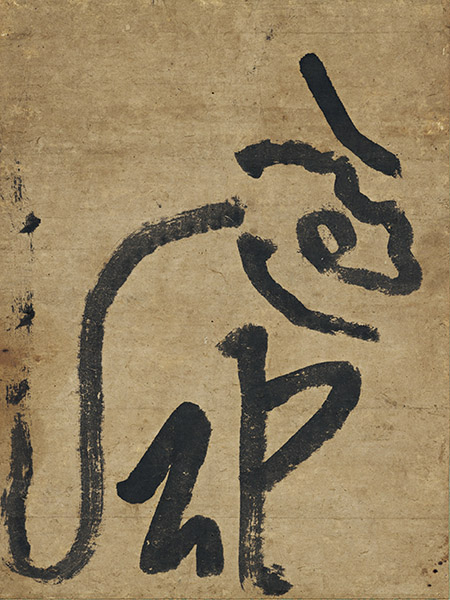
Calligraphy, “Tiger” in One Large Character
By Kokan Shiren
Reigen-in Temple, Kyoto
Chapter 3 The Legendary Buddhist Painter Minchō
Inseparable from the history of Tōfuku-ji is the name of the Buddhist painter Kissan Minchō (1352–1431). Up until the Edo period, Minchō was revered as one of Japan’s most famous artists. Inspired by Chinese Buddhist paintings, Minchō developed a distinctive style that fused precise ink brushwork with vivid coloration. The monumental scale of his works was well suited to the grandeur of Tōfuku-ji’s precincts. This chapter introduces treasured masterpieces by Minchō that have been passed down within Tōfuku-ji and its subtemples for centuries.
![Important Cultural Property. Bodhidharma, Liu Haichen, and Li Tieguai. By Kissan Minchō. Tōfuku-ji Temple, Kyoto. [on view: November 7–December 3, 2023]](/jp/exhibitions/assets/special/tofukuji_2023/tofukuji2023_101_2_2F-4.jpg)
Important Cultural Property
Bodhidharma, Liu Haichen, and Li Tieguai
By Kissan Minchō
Tōfuku-ji Temple, Kyoto
[on view: November 7–December 3, 2023]
Chapter 4 Zen Culture and International Exchanges
Studying Zen in China left a lasting impact on the monk Enni. Even after returning to Japan with a vast assemblage of Buddhist texts and artifacts, he maintained firm ties with China’s Buddhist community. This network of overseas exchange was inherited by the Shōichi denomination. Enni’s successors were actively engaged in diplomacy and trade, thereby accumulating various items that fostered the development of Zen culture in Japan. In this way, Tōfuku-ji played a significant role in Japanese cultural history through its development as hub for international relations.
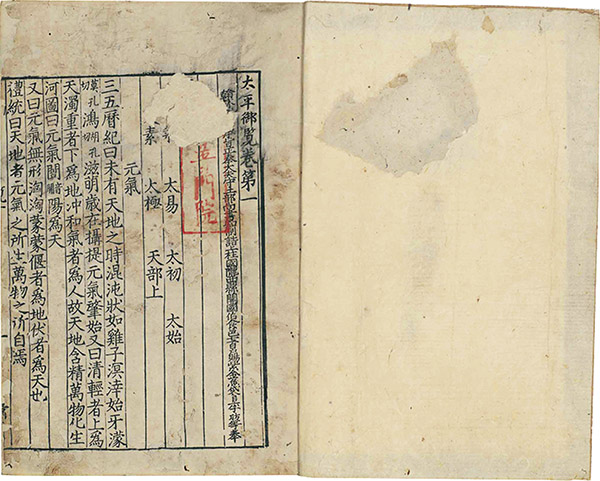
National Treasure
Imperial Readings of the Taiping Era (Ch: Taiping yulan)
Tōfuku-ji Temple, Kyoto
Chapter 5 Tōfuku-ji’s Monumental Buildings and Buddhist Sculptures
The sheer size of Tōfuku-ji is epitomized by its massive Buddhist sculptures and sprawling temple complex, whose structures tower over Kyoto’s Eastern Hills. When Tōfuku-ji was first built, it featured a Song-style seven-hall layout and housed a group of monumental statues, including a massive seated Shakyamuni Buddha as its principal image of worship, for which it was known as the “New Great Buddha Temple” (Shin Daibutsu-ji). Despite numerous disasters throughout its history, Tōfuku-ji has continued to maintain and reconstruct its buildings and subtemples. For this reason, it still preserves the splendor of Zen architecture, sculpture, painting, and calligraphy to this very day.
![Important Cultural Property. Tōfuku-ji Temple Precincts. Inscription by Ryōan Keigo. Tōfuku-ji Temple, Kyoto. [on view: November 7–December 3, 2023]](/jp/exhibitions/assets/special/tofukuji_2023/tofukuji2023_174_2_1F-1.jpg)
Important Cultural Property
Tōfuku-ji Temple Precincts
Inscription by Ryōan Keigo
Tōfuku-ji Temple, Kyoto
[on view: November 7–December 3, 2023]
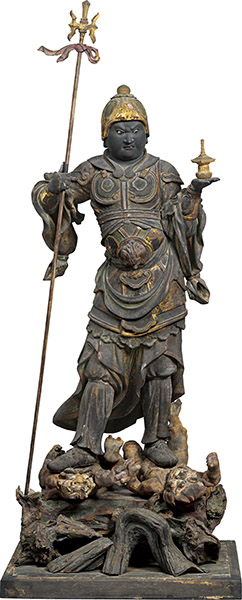
Tamonten (Vaiśravaṇa) Statue
From Standing Four Heavenly Kings
Tōfuku-ji Temple, Kyoto




